The most detailed map of the brain EVER seen: stunning images reveal all 139,255 neurons – and the 50 million connections between them
The structure of the brain is one of the most mind-bogglingly complex puzzles in the universe.
But now an international team of scientists has created the first map showing every neuron and connection in the adult brain.
This ‘wiring diagram’, created by the FlyWire Consortium, reveals each of the 139,255 neurons in a fruit fly’s brain and the 50 million connections between them.
Although the human brain has about a million times more neurons than that of a fly, the researchers say this brings us closer to understanding our own minds.
Co-leader of the project Dr. Gregory Jefferis, from the University of Cambridge, says: ‘Brain wiring diagrams are a first step towards understanding everything we are interested in: how we control our movements, answer the phone or recognize a friend. ‘
An international team of scientists has created the first map showing every neuron and connection in the adult brain
Although the brain of an adult fruit fly is less than one millimeter in diameter, it is still an enormously complex structure to study.
To create this groundbreaking map, the brain of a female adult fruit fly was carefully cut into 7,000 segments, each just 40 nanometers thick.
Each slice was then scanned individually using a high-powered electron microscope to reveal the individual cells that make up the brain.
The resulting dataset took up 100 terabytes of storage space, the equivalent of 2,500 high-definition movies.
The researchers developed an AI capable of reconstructing a map of the brain by identifying every neuron and connection.
However, since the AI was still prone to some errors, a team of 287 researchers from more than 76 labs around the world searched the entire data set to check for errors.
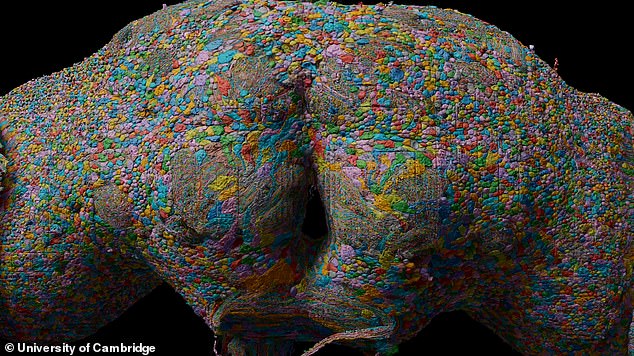
The map contains the location of 139,255 neurons and 50 million connections between them
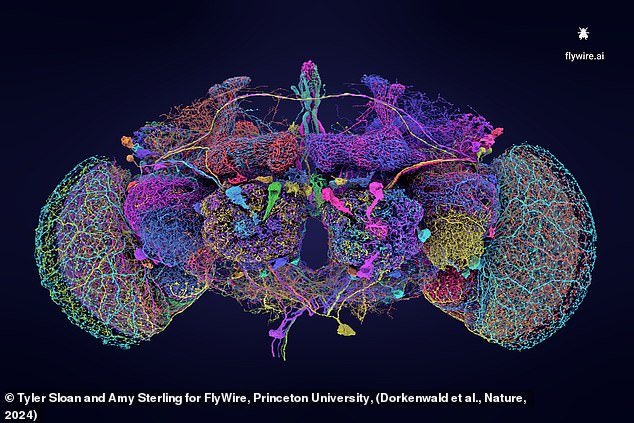
The researchers cut a fly brain into 7,000 slices and scanned them with an electron microscope to reveal how each neuron is connected to the entire brain.
If an individual had worked non-stop to verify the data, the researchers estimate it would have taken 33 years to complete the project.
Although the effort was enormous, the reward is the most detailed map of the brain of any animal ever produced.
This map was published in two articles in Nature and has been made openly available to other scientists.
Compared to previous attempts to detail small parts of a fly’s brain, this new map contains seven times more neurons and records 54.5 million individual connections.
Previously, the largest brains to be fully mapped belonged to fruit fly larvae, which have 3,016 neurons, or to nematodes, which have only 302.
This is the first time scientists have been able to map the brain of an animal that can walk, see and exhibit complex behavior.
The researchers think this could pave the way to understanding the fundamental dynamics that make complex behavior possible.
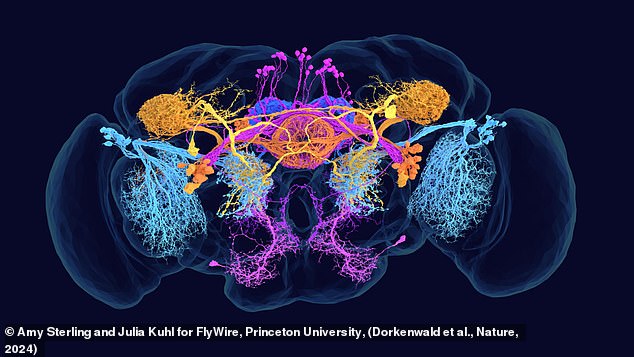
This map reveals the brain’s connections in never-before-seen detail and contains seven times more neurons than previous maps. This image shows different cells color-coded based on the chemicals they use to transfer information
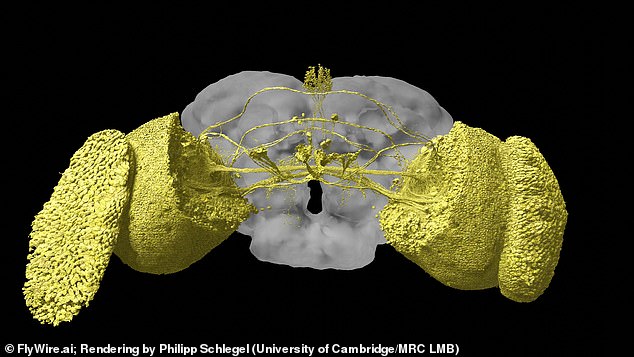
The map also allows researchers to study the brain regions responsible for different skills. For example, this image shows the visual system of a fly
Dr. Jefferis says: ‘Flies can do all kinds of complicated things, such as walking, flying, navigating, and the males sing to the females.
‘If we want to understand how the brain works, we need a mechanistic understanding of how all the neurons fit together and make you think.’
One insight that has already emerged from the research is that our brains may not be as unique as we think.
Compared to previous partial brain maps, the researchers found significant similarities in the way the neurons connected.
This suggests that our brains may not be “a unique structure like a snowflake,” but rather follow set patterns.
The researchers found that only 0.5 percent of neurons in the brain had variations that caused them to be wired differently.
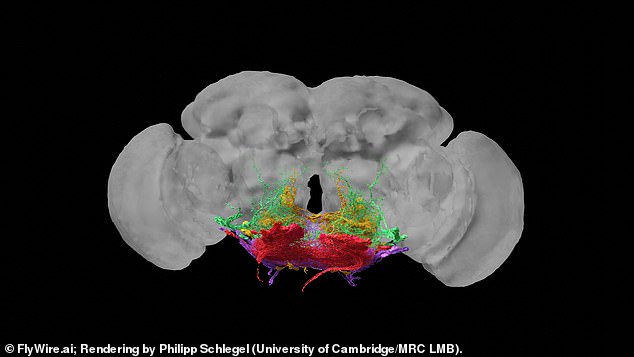
This map shows the 100 neurons that make up a fly’s motor system. This is the first time researchers have mapped the brain of an animal that can walk and see
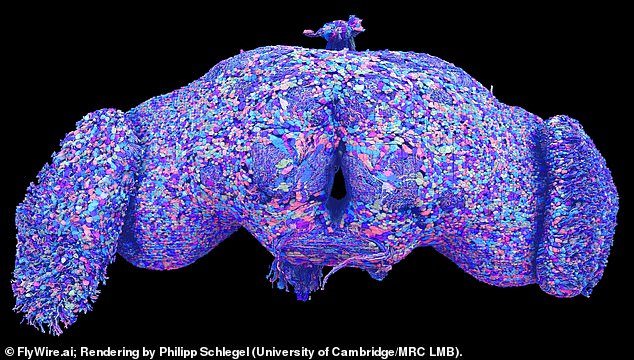
Although a fly brain contains a million times fewer neurons than a human brain, the researchers hope this could provide the basis for studying the brains of larger organisms.
These miswired neurons can be the source of our mind’s individuality or brain dysfunction.
However, seeing how the neurons fit together is only the first part of the puzzle.
If scientists want to digitally simulate the brains of fruit flies, we also need to know what all parts of the brain do.
Co-first author Dr Philipp Schlegel, from the MRC Laboratory of Molecular Biology, says: ‘This dataset is a bit like Google Maps, but for the brain: the rough wiring diagram between neurons is like knowing which structures appear on satellite images of the Earth match streets and buildings.
“Annotating neurons is like adding names for streets and places, business hours, phone numbers, reviews, etc. to the map – you need both to be really useful.”
The researchers have already identified more than 8,400 unique cell types responsible for skills such as vision or movement, including 4,581 previously unknown types.
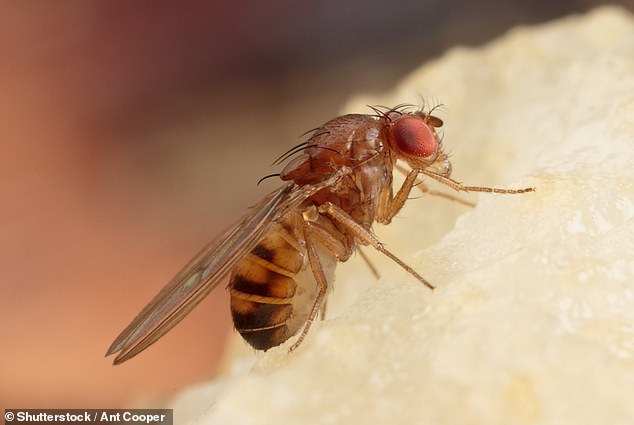
Because fruit flies are capable of complex behavior, mapping their brains allows researchers to learn more about the neural circuits that make this possible
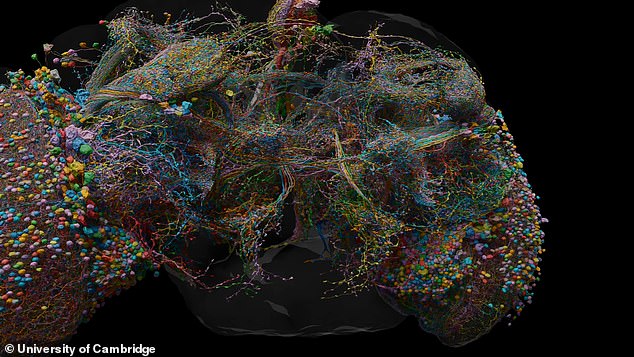
The next goal will be to identify the role of individual neurons within the map (photo) so that researchers can begin to simulate brains digitally.
These allow us to see, in neuron-by-neuron detail, the structures responsible for a fly’s natural navigation skills, their ability to recognize shapes and even how they listen to each other’s songs.
Because fruit flies are a common animal in research labs around the world, the researchers believe these insights will provide deeper insight into the inner workings of the brain.
Co-lead researcher Professor David Bock, from the University of Vermont, said: ‘This will inevitably lead to a deeper understanding of how nervous systems process, store and retrieve information.
‘I think this approach points the way forward for the analysis of future whole-brain connectomes, both in the fly and in other species.’
